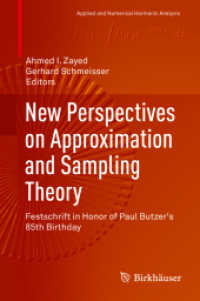- ホーム
- > 洋書
- > ドイツ書
- > Mathematics, Sciences & Technology
- > Technology
- > electronics, electrical engineering, telecommunications
Full Description
This book presents an investigation on integrating wireless sensor nodes including their antennas into fiber metal laminates (FMLs) for the purpose of enabling wireless, material-integrated structural health monitoring.
Within the scope of this work, a digital sensor node is presented, which can be fully integrated into a conductive host material. A stainless steel antenna supplies the system with sufficient power to provide the functions required for its intended use. This system enables the wireless readout of sensor data for the detection of damage in FMLs. The application focuses on aerospace components, for the detection of damage in the inner material layers, which are not or only hardly detectable by optical inspection methods. Guided ultrasonic waves in the form of Lamb waves are used for this. The flexible electronics are inserted into the layers of the target material, while the associated antenna is cut into the outer metal layer. This turns the outer metal layer, which would prevent wireless communication from inside the laminate, into an advantage, as the need for an additional, external antenna is eliminated. Two fundamentally different principles can be used as the sensor element. Piezoelectric sensors were already used extensively in structural health monitoring using ultrasound and recently developed piezoresistive sensors, which are designed to be very small, making them highly suitable for material integration. Both types of sensors can be read out with the presented system so that the most appropriate approach can be chosen depending on the application. The suitability of the wireless sensor system for its intended purpose is verified by material-integrated measurements. At the end of this work, it is shown that the raw data of the measurements reproducibly provide a sufficient resolution of the sensor signal to manually identify changes caused by applied reversible, artificial pseudo-defects from reference measurements without any damage.
The intended audience of this book are people from the field which are familiar with the basic concepts of electrical engineering or similar regions, embedded system enthusiasts and all readers who like to follow the process of a complete wireless electronic system design from requirements analysis to final material-integrated measurement demonstrations.
Contents
Chapter 1. Introduction and Overview .- Chapter 2. Fiber Metal Laminates.- Chapter 3. Wireless Interface.- Chapter 4. Embedded Electronics.- Chapter 5. Structural Health Monitoring.- Chapter 6. Conclusion.








